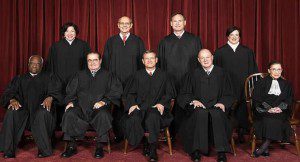
On Tuesday, the Supreme Court decided that Michigan’s ban on affirmative action in college admissions was ok. The nation’s top court’s judgment sent minor ripples across the country with some feeling that race relations, or at least upward mobility in America for minorities, took a leap backwards.
So to understand how well affirmative action has worked for minorities, specifically black Americans, The New York Times published an article about how affirmative action bans in certain states have impacted blacks and Hispanics.
California banned the practice of affirmative action in college admissions 16 years ago, and according to the article, black freshman enrollment at Cal-Berkeley dipped to just two percent as recent as 2011.
In Florida the ban was instituted in 2001, and for blacks, there was no noticeable decrease until 2011. Enrollment figures for black students remained steady from about 2001-2005. From ’05 through 2011, that number dropped to just seven percent.
For me, that shows that affirmative action is still needed. As cliché as this next sentence may sound, we have made great progress since the sunset of Jim Crow.
But allow me to remind you that the end of Jim Crow was just 49 years ago. How are we able to arbitrarily apply a year, or number, to when discrimination ends?
In his retort to a comment made by Justice Sotomayor about race, Chief Justice John Roberts said that affirmative action does more harm than good. Embedded in his comment are words that will sting many that fought the ugly war against Jim Crow.
For so many black men and women in this nation, their government had to provide a fair and equal opportunity for access to so much, including education.
Justice Sotomayor alluded to affirmative action aiding her in her four page dissent regarding the court’s decision.
What simmers below the surface is an anger that white men and women are able to decipher when enough equality is enough; that reverse racism and discrimination is becoming a problem that needs to be addressed.
Affirmative action now hurts far too many white people, so that means that we should pull the rug from under black students.
I know that race makes many uneasy. When talking about skin color, the easy way out is to simply ease out of the back door by saying something like, “why is race always brought up?” “Or why should skin color matter?”
Undertaking the heavy lifting on race relations in this nation is hard, as it should be. This nation has an ugly history of racial discrimination that sometimes rears its ugly head. The problem that we have now is that we use the guise of racial progress through President Obama and a few rich professional ball players as victory.
Simply disagreeing with the spirit of affirmative action because it doesn’t provide a blueprint on discrimination and who falls under the minority umbrella is cheap and lazy.
Tuesday’s decision on affirmative action isn’t a sign of forward progress, it’s a signal that we aren’t doing enough to ensure equality for all.



[…] another example: The United States Supreme Court recently passed on forcing the University of Michigan to apply affirmative action because its not the court’s […]